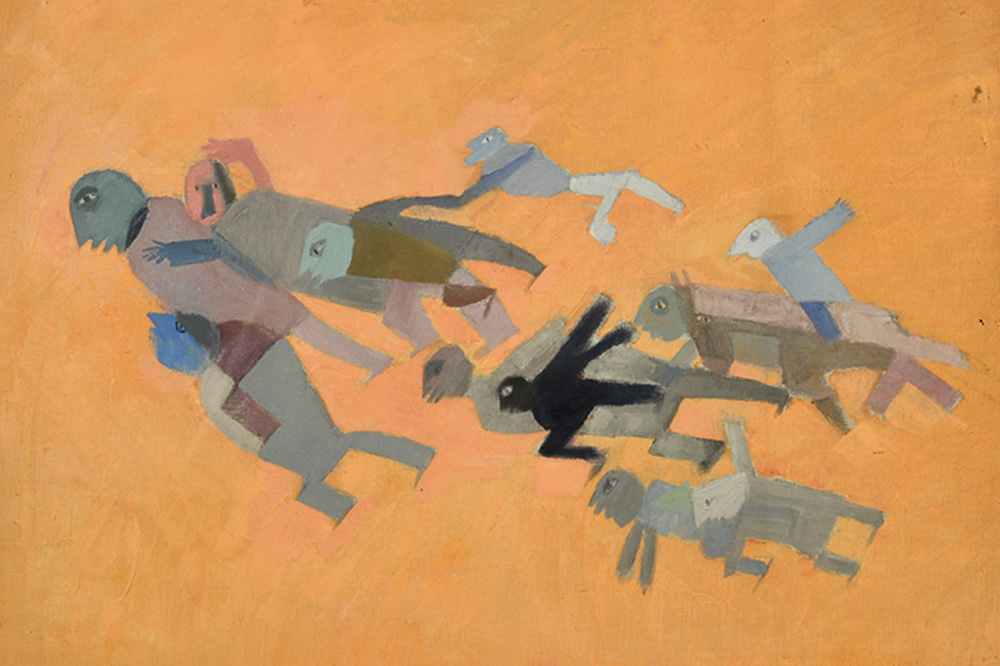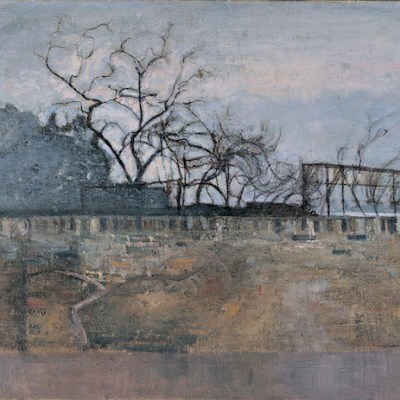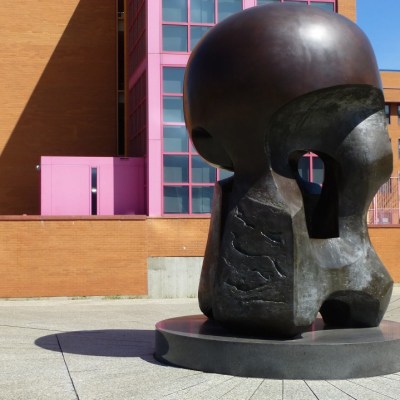From the May 2022 issue of Apollo. Preview and subscribe here.
The Barbican is an apt location to stage an overview of the post-war years in Britain, emblematic as it is of what rose from the wreckage of the Second World War. Its survey of art from this time ends when the construction of the Barbican Estate began in 1965. Absent are artists like Henry Moore and Barbara Hepworth, who were already big names by 1939, leaving space for those who came later and were at much greater risk of being forgotten as more expressive movements in New York caught the eye of critics. However, the focus here on Britain avoids feeling claustrophobic, with many artists originating from across Europe as well as the Philippines, India, Zambia and Guyana.
The largest space is given over to the defaced post-war landscape in which these artists found themselves. William Turnbull’s experiences as a fighter pilot show through in a fleet of strange reliefs, in which plain structures dotted over a small scale terrain heighten the modern landscape’s mundanity. Back on earth, the scrawny and disfigured birds of Elisabeth Frink bear a disturbing resemblance to shrapnel. Hovering over all is the rickety, skeletal form of Lynn Chadwick’s The Fisheater (1951), an animalistic machine with Calder-inspired mobile elements created for the Festival of Britain. Such micro and macro views are offered throughout – Prunella Clough’s aerial view of a modern cityscape is hung beside her equally abstracted interpretation of the twisted grid of an electrical network. The similarities speak for themselves.
First Contact (1958), John McHale. Collection Albright-Knox Art Gallery, Buffalo, New York, © Estate of John McHale, photograph: Brenda Bieger for Albright-Knox Art Gallery
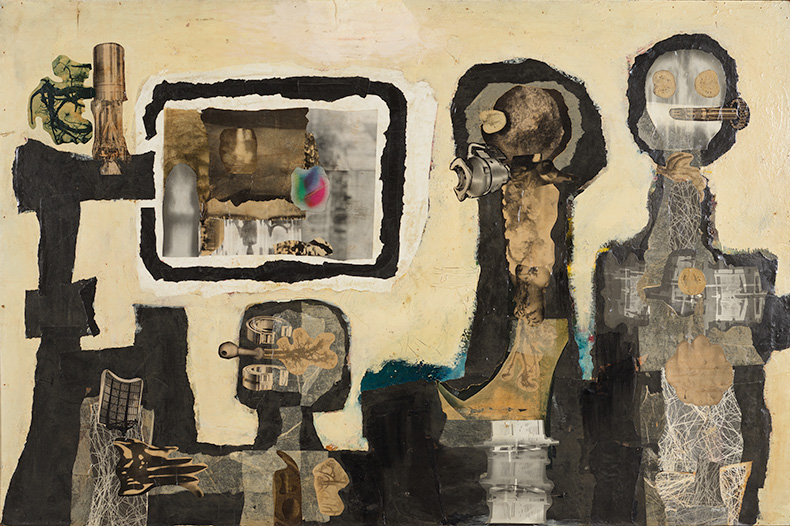
Another room, dedicated to the body, offers a pleasing expansion on familiar themes. John McHale’s collage First Contact (1958), in which a family is represented as part organic and part machine, echoes the darker preoccupations of Hannah Höch or John Heartfield working in Germany some decades earlier. The cyborg, with its inevitably male silhouette, is a striking presence in the sculptures of Eduardo Paolozzi. Elsewhere, however, are outcomes of war that are less tempting to the imagination. In her unflinchingly gory anatomies, recognisably those of women, Magda Cordell is, we are told, reflecting on the body as a site of trauma and regrowth. Still more ambiguously abstract are the flushed orange and red canvases of Aubrey Williams, marked by circling pools of darkness. In Eleven Persons and One Donkey Moving Forwards (1947), Franciszka Themerson shows a flock of bodies appearing to swoop in flight, a meditation on her exile from Poland.
The great many smaller rooms lining the exhibition space allow for a series of focused meditations that play with our assumptions about the era. A grouping of works by Francis Bacon and David Hockney that allude to cruising speaks to the light and joyful as well as more ominous or angst-ridden sides of night life. Well-known depictions of domestic friction by Lucian Freud offer a gloomy backdrop against which radiate Sylvia Sleigh’s once taboo portraits of her young lover Lawrence Alloway in a wedding dress. Meanwhile, visitors who linger too long in the section dedicated to husband and wife John Bratby and Jean Cooke are at risk of finding themselves psychologically embroiled in the fractured and oppressive partnership of those artists.
A more straightforwardly inviting room of works by Shirley Baker and Eva Frankfurther, paired for their interest in marginalised figures, cannot go unmentioned. Frankfurther’s sombre paintings of instantly familiar, if unwaveringly gloomy, characters are a highlight. Dispiriting or fatalistic perspectives such as these, which run through the show, are balanced out by the everyday grit and good cheer evident in Baker’s photographs of soon-to-be-displaced working-class communities in Manchester. They remind us that, outside of artistic contemplation, life marches on.
Head of Gerda Boehm (1964), Frank Auerbach. Sainsbury Centre for Visual Arts, © The Artist. Courtesy of Marlborough Gallery, London, photograph courtesy Sainsbury Centre for Visual Arts
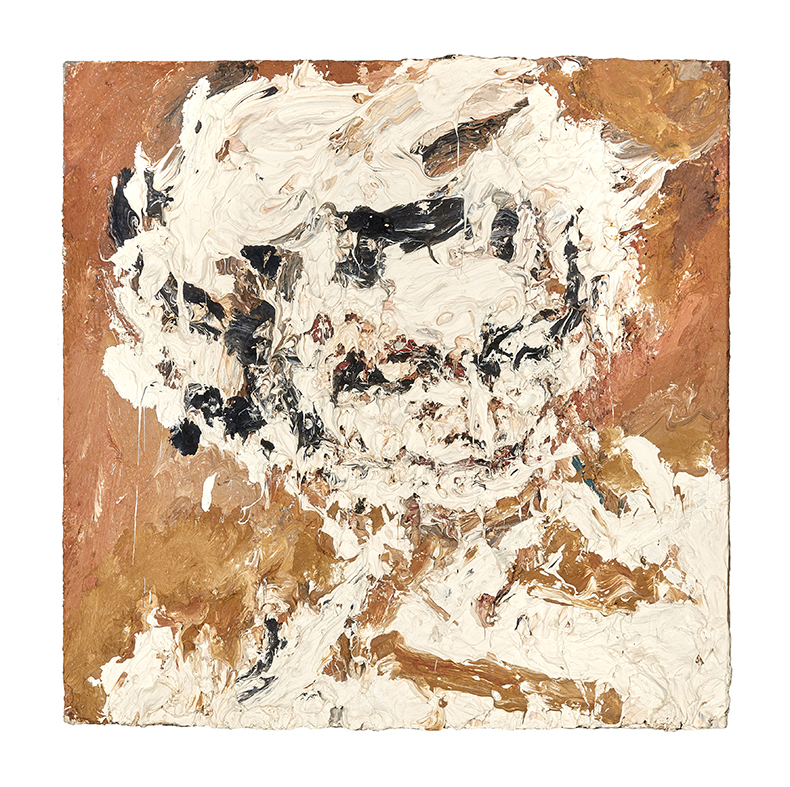
Few works recall developments across the Atlantic, one exception being the mass of riotous squiggles in Alan Davie’s Creation of Eve (1956). Its inclusion flatters the candidly figurative approach taken by members of the School of London such as Leon Kossoff and Frank Auerbach, the latter represented by the irresistible Head of Gerda (1964). In one corner, however, we find that a circle established by Victor Pasmore made small-scale geometric abstractions of a markedly scrappy and makeshift quality, of which Mary Martin’s serene monochromatic constructions are easily the most impressive. On canvas, meanwhile, Britain’s abstract painters suffuse their paintings with pictorial references, like Frank Bowling’s flying birds, or decorative motifs, as in the Islamic-inspired designs of Anwar Jalal Shemza. While pleasing, they are a far cry from what Clement Greenberg identified as Colour Field painting.
Inevitably, however, by the 1960s we see glimpses of new media and conceptual art. The final room recreates an installation by Gustav Metzger in which chromatic patterns created inside glass slides in a projector are magnified across the walls. Elsewhere, his ‘auto-destructive’ series is shown through surviving footage of a live demonstration on the streets of London, during which acid erodes a painting’s surface. David Medalla’s Sand Machine (1963), a bizarre and evidently experimental work in which a rotating machine drags a string of beads through a shallow pile of sand, ends the exhibition in a flourish that makes full use of the Barbican’s idiosyncratic space. Given the layout, the visitor can, by looking side to side, place this work in conversation with Chadwick’s The Fisheater, at the very start of the exhibition. The comparison emphasises just how much the aims of artists had changed in those 20 years after the war.
‘Postwar Modern: New Art in Britain 1945–1965’ is at the Barbican Art Gallery, London, until 26 June.
From the May 2022 issue of Apollo. Preview and subscribe here.
